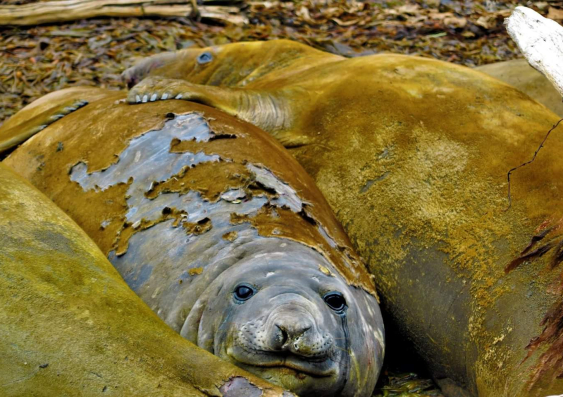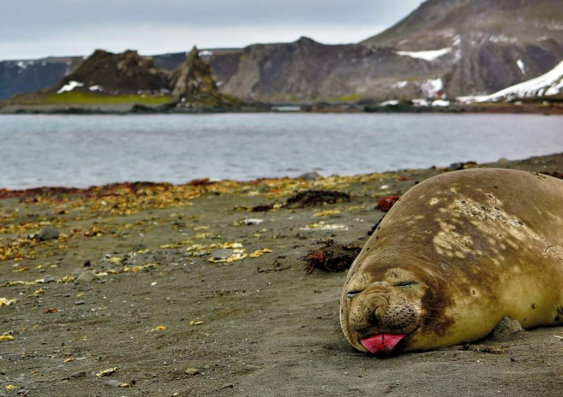Male southern elephant seals are picky eaters, study suggests
New research suggests these large marine mammals are extremely fussy and only eat their favourite foods.
New research suggests these large marine mammals are extremely fussy and only eat their favourite foods.

Ben Knight
UNSW Media & Content
(02) 9065 4915
b.knight@unsw.edu.au
As one of the top predators roaming Antarctica, the sizeable southern elephant seal has its fair selection of the menu. But it turns out they don’t just want to eat anything and everything.
According to new research led by UNSW Sydney, opens in a new window, male southern elephant seals have their own favourite foods, and they like to stick with them. In other words, they’re very fussy eaters.
“They could have the pick of the buffet, and yet each male southern elephant seal eats a lot of the same food, which is just a fraction of what’s on offer,” says Andrea Cormack, lead author of the study and a PhD candidate at UNSW Science. “So, they are extremely picky eaters, each with their own unique favourite foods they go after, whether it be fish, squid species, crustaceans or octopus.”
The research, published in the journal Marine Ecology Progress Series, opens in a new window, is one of the first studies to analyse the diet of adult male southern elephant seals, who, despite their impressive size, are relatively understudied compared to females.
“We didn’t specifically compare males to females in this study,” Ms Cormack says. “But females are known to maintain a fairly specialised diet between one another, just nowhere near as extreme as what we found with the males in our research.”

Male southern elephant seal diets are relatively understudied compared to females. Photo: Andrea Cormack.
Getting close enough to study the diet of male elephant seals in the wild can be challenging, given their powerful stature and aggressive temperament – they can weigh up to four tonnes, dwarfing their more placid, smaller female counterparts. Instead, researchers analyse the composition of smaller hard tissues back in the lab that keep more detailed records of the animal’s activity.
For the study, the scientists inferred the eating habits of 31 male southern elephant seals from the Western Antarctic Peninsula by analysing a whisker sample from each seal that holds stable isotopes – chemical clues about the food they’ve eaten in the past. Each whisker analysed in the study contained up to a year’s worth of data about each seal’s culinary preferences, allowing the team to assemble the most extensive picture of the male southern elephant seal diet to date.
“These guys are out in the water foraging for months, and then fasting for two to three months on land during breeding season, so it’s hard to gather a lot of information about their diet through study methods like stomach analysis,” Ms Cormack says. “But by analysing hard tissues that store an inert chemical record of what they’ve eaten, we can start putting together the pieces about their eating habits.”
Read more: The secret life of Tasmanian devils is hiding in their whiskers
The researchers found nearly all male southern elephant seals are specialists, with individuals consistently eating the same food items over time with little variation in diet. Most of those could be considered extreme specialists, feeding on less than 20 per cent of their population’s range of food types. Meanwhile, only one seal in the sample was a generalist and chose to eat a broad diet of various food sources.
“The Antarctic ecosystem has a lot of variety, but male southern elephant seals don’t like to mix it up,” says Professor Tracey Rogers, a marine ecologist at UNSW Science and senior author of the study. “They each have their own favourite foods, and they stick to them despite all the options available.”

Female southern elephant seals are also picky eaters – but nowhere near as fussy as males. Photo: Andrea Cormack.
The study found variation between individuals strongly correlated with their body size. The heaviest seals ate further up the trophic scale, or food chain. In other words, they ate larger energy-dense prey, such as big squid, leading up to the breeding season.
But it wasn’t the size of the seal that determined specialisation. Even seals on the smaller end that fed further down the trophic scale on smaller fish were extreme specialists from early adult life.
“They were all consistently picky on their food type regardless of size,” Ms Cormack says. “For these guys, who can lose up to 50 per cent of their body weight during the breeding season when they’re fasting on land, what you choose to eat could be very important.”
The researchers don’t know the exact cause of the male’s picky eating habits but suspect it could be for many reasons including gape size, which may dictate ideal prey size and feeding technique, to fluctuations in seasonal and yearly food availability.
Specialisation could also have several ramifications. Concentrating on different, but very particular food types – even a subpar option– could help improve foraging success rates between male seals and allow them to gain the size needed to compete with other males for breeding rights.
“We know from previous studies that individuals will often return each year to the same feeding grounds in search of their favourite foods,” Ms Cormack says. “But we need more studies to be confident about exactly what’s driving specialisation and how it impacts breeding success.”

Dreaming about dinner. Photo: Andrea Cormack.
Thanks to conservation efforts, the southern elephant seal population has bounced back after being hunted to near extinction and is no longer considered endangered. However, the risk of a new decline looms from the impact of climate change.
For example, climate-driven shifts in the Southern Ocean can change krill availability, which impacts the seal’s ability to feed on its favourite foods further up the food chain. Furthermore, emerging pathogens like deadly avian flu strains also threaten to wipe out populations.
“The Western Antarctic Peninsula, where these incredible animals live, is one of the areas experiencing the greatest changes from ocean warming,” Prof. Rogers says. “The ice cliffs are almost completely gone, and the periods where new ice forms are getting shorter, changing the whole ecosystem. This could be problematic, with climate change affecting food resource availability across the Southern Ocean, which is why we need more research.”
Read more: Ocean warming is accelerating, and hotspots reveal which areas are absorbing the most heat
Future work would also benefit from increasing the sample size to make the analysis more robust, looking at groups of male southern elephant seals from other colonies around the Southern Ocean, and more satellite tracking to improve our understanding of the seal’s dietary specialisation.
“We’ve established a solid foundation of evidence about how the individual diets of male southern elephant seals vary,” Ms Cormack says. “It would be great to do more longitudinal-type studies to continue building our knowledge of male southern elephant seal specialisation and its impacts.”
The study also involved co-authors from the Argentine Antarctic Institute and Alfred Wegener Institute for Polar and Marine Research.